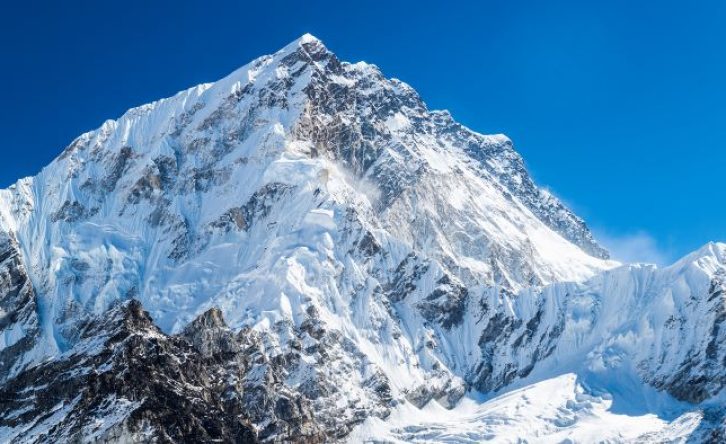Overview
Mount Everest, also known as Sagarmatha in Nepali and Chomolungma in Tibetan, is the highest peak on earth standing at an altitude of 8848.86m. The exploration of Mount Everest has a long and varied history, from the first recognition of the peak to the successful attempt of the British and the impressive solo ascent of Reinhold Messner. Herein, we will take you through the history of Mount Everest expedition, its climbing routes, permit costs, and the climbing period.
The First Recognition of Mount Everest
Mount Everest was first officially measured in 1856 during the Great Trigonometric Survey of the British Indian government and then known as Peak XV certified with a height of 8840m. With simple technology and the distance from the mountain, the height was determined with really phenomenal accuracy – only 8m off from the current value of 8848m. The name of the British Surveyor in 1856 was Sir George Everest- the General of British India during the survey period and a somewhat infamous character. Tibet and Nepal were closed to foreigners at the time, so it is reasonable to assume that the local names of the mountain were unknown. The name of the highest peak was chosen in his honor, although not without controversy even at the time.
Early Attempts and Success
The first climbing attempts were not possible until the 1920s, and they ended ultimately in disaster. The first successful summit of Mount Everest was achieved by Sir Edmund Hillary and Tenzing Norgay Sherpa on May 29, 1953, from the South side on the very same route that climbers still use today. The expedition was led by Sir John Hunt. Since then, many climbers have attempted to climb Mount Everest, making it one of the most popular and challenging mountain expeditions in the world.
Climbing Routes
The climbing routes to the summit of Mount Everest are divided into two sides: the South side in Nepal and the North side in Tibet. The South side is technically a trekking route with a little objective danger once past the Khumbu icefall apart from a few crevasses and Seracs bridged by ladders, a couple of short ice cliffs around camp 3, and rock sections protected with fixed lines. The Khumbu Icefall is a steep glacier with an obvious implication of large crevasses and treacherous unstable Seracs making navigation complicated and riddled with a high objective danger of falling ice. This is the most dangerous part of the climb. The North side is considered more challenging but less crowded than the South side, with more technical climbing and a higher altitude.
Permit Costs
Climbing Mount Everest is an expensive endeavor, with permit costs varying depending on the climbing route. In Nepal, the permit cost for the South side is $11,000 per person for a single climb during the spring season, while the permit cost for the North side in Tibet is $9,950 per person. These costs do not include the cost of a climbing guide, Sherpa support, gear, and other expenses.
Climbing Period
The climbing period for Mount Everest typically lasts 60-90 days, depending on the weather conditions. The best time to climb Mount Everest is during the spring season from April to May, when the weather is relatively stable, and the winds are calm. During this period, climbers can expect to experience cold temperatures, high winds, and low oxygen levels.
Approaches to Everest Base Camp
The approach to Everest Base Camp on the South side is through the Khumbu region of Nepal, leading up to the Khumbu Glacier extending down to Lobuche (4940m). It starts with a flight to Lukla and a trek from Lukla to Everest South Base Camp (5364m) via Namche Bazaar (3440m)-Tengboche (3860m)-Pheriche (4371m)-Lobuche (4940m)-Gorak Shep (5164m). It takes typically 8 days to reach ABC from Kathmandu.
Climbing Routes South Side
The South route is technically a trekking route with a little objective danger once past the Khumbu icefall apart from a few crevasses and Seracs bridged by ladders, a couple of short ice cliffs around camp 3, and rock sections protected with fixed lines. There is an obvious danger of high altitude sickness complications and changeable, unpredictable mountain weather. The Khumbu Icefall is a steep glacier with an obvious implication of large crevasses and treacherous unstable Seracs making navigation complicated and riddled with a high objective danger of falling ice. This is the most dangerous part of the climb.
Camp 1 (6000m)
Camp 1 of an Everest expedition is a crucial resting and acclimatization point located on the southeastern ridge of Mount Everest. It is typically situated at an elevation of around 6,000 meters (19,685 feet) above sea level. Camp 1 serves as an intermediate camp between Base Camp (5,364 meters/17,598 feet) and higher camps on the mountain.
This camp is usually established by mountaineering teams during the early stages of their ascent. It is strategically positioned to provide climbers with a place to rest, recover, and adjust to the high altitude. The campsite is chosen carefully to ensure it is safe from avalanches, rockfall, and other potential hazards.
Camp 2 (6400m)
Camp 2 is located in a lateral moraine at the bottom of the west ridge. This camp in Everest expedition is a significant campsite located on the slopes of Mount Everest, further up the mountain from Camp 1. It is situated at an elevation of approximately 6,400 meters (21,000 feet) above sea level. Camp 2 serves as a crucial acclimatization point and a stepping stone towards higher camps on the mountain.
Reaching Camp 2 requires climbers to traverse steep slopes, negotiate rocky sections, and potentially cross crevasses. This part of the climb is physically demanding and requires endurance, technical skills, and careful attention to safety.
Camp 3 (7200m)
It is located on a small ledge on the Lhotse wall. It is a vital high-altitude camp situated on the slopes of Mount Everest, positioned higher up from Camp 2. It is located at an elevation of approximately 7,200 meters (23,600 feet) above sea level. Camp 3 serves as a crucial acclimatization point and a significant stepping stone towards the ultimate goal of reaching the summit.
This camp is strategically positioned to allow climbers to continue their acclimatization process at a higher altitude. It is usually established on a rocky ledge or a relatively flat area, carefully selected to provide a safe and secure resting place. The campsite is chosen to minimize the risk of avalanches and other potential hazards.
Camp 4 (7950m)
The final camp for Everest expedition is located at South Col; it is easily accessible by the majority of climbers without supplementary oxygen. Camp 4 of an Everest expedition is a critical and final high-altitude camp located near the South Col, the prominent saddle between Everest and the neighboring peak Lhotse. It is situated at an elevation of approximately 7,950 meters (26,085 feet) above sea level, just below the treacherous slopes leading to the summit.
Camp 4 serves as the last camp before the final push to the summit of Mount Everest. It is strategically positioned to provide climbers with a brief resting point and a launching pad for their summit bid. The campsite is carefully chosen for its relative shelter and proximity to the South Col, which acts as a gateway to the summit.
Safety
Climbing Mount Everest is a serious undertaking, and safety is a top priority. Mistakes can have serious consequences, and the risk of high altitude sickness, changeable weather, and objective danger is always present. Climbing guides and staff are highly qualified, skilled, and regularly reviewed and re-trained, recognized for their training and experience throughout the profession. Rigorous safety standards are implemented to minimize the risk, and ethical standards are followed for the employment of guides and staff.
Trip Itinerary
Cost Include / Exclude
What’s include
- Airport transfer (Airport – Hotel – Airport) by private vehicle
- 4 Nights 3 Star Hotel in Kathmandu Including Breakfast
- Lukla flight ticket
- Everest national park fees and Local government tax
- Mt. Everest expedition permit (US$ 11,000 for member).
- Full board meals on the trek (Breakfast, Lunch and Dinner)
- Hot Drinks : Tea / Coffee
- All accommodations in lodges/tea house / Tented camp
- Climbing Sherpa Guide and their insurance
- Necessary sherpa porters / Yak
- Emergency oxygen – mask and regulator use (If use, pay it)
- Medical supplies (first aid kit will be available)
- All government taxes and service charge.
- welcome dinner / farewell dinner
What’s excluded
- International airfare and Nepal entry visa fee
- Personal Travel Insurance and emergency rescue evacuation if required.
- Lunch and dinner in Kathmandu
- All the Bar bills and personal expenses (phone call, laundry service, battery recharge,
- All kinds of drinks, Hot Shower, WI-FI
- Summit bonus to the personal climbing Sherpa
- Tips



